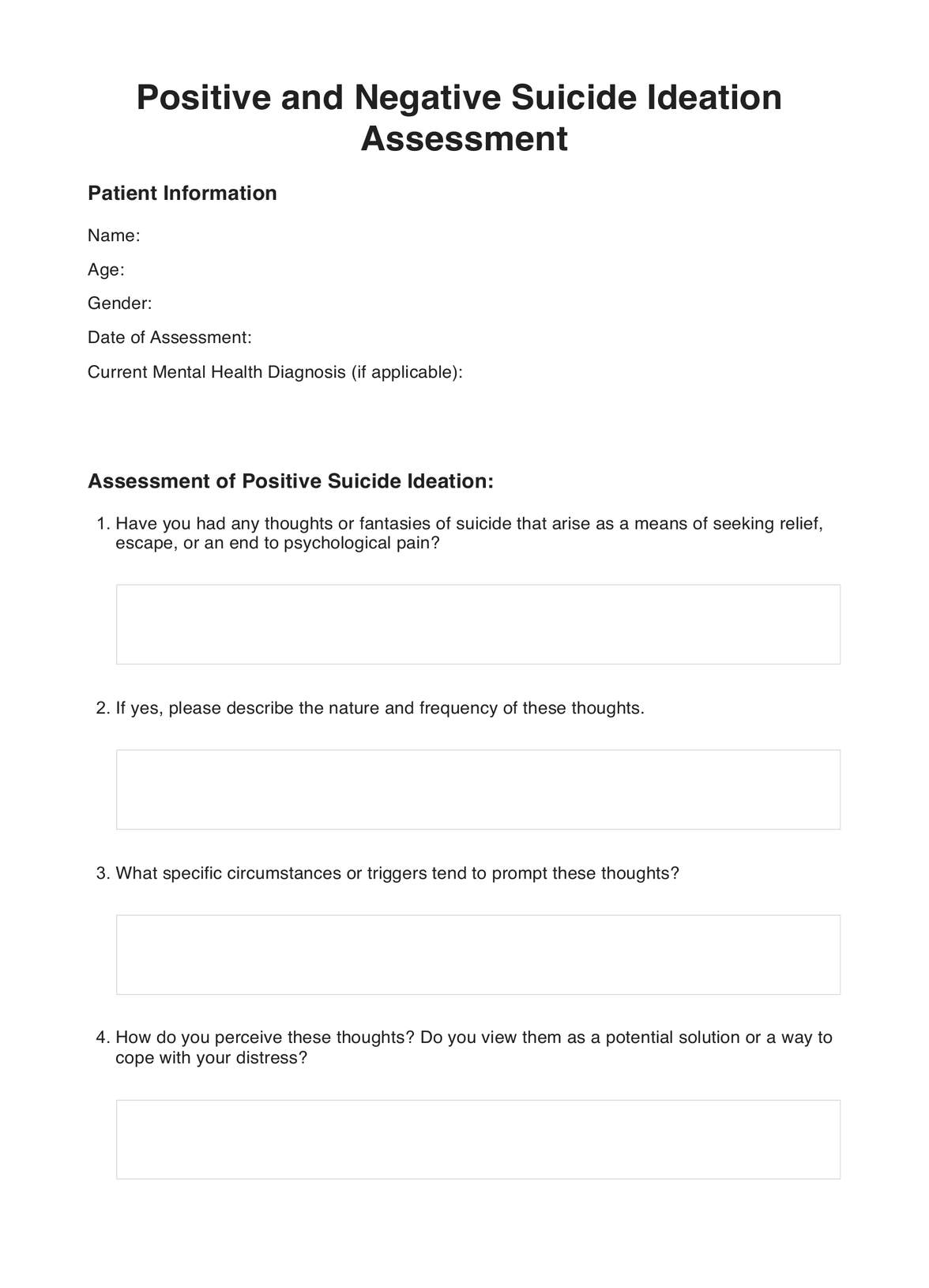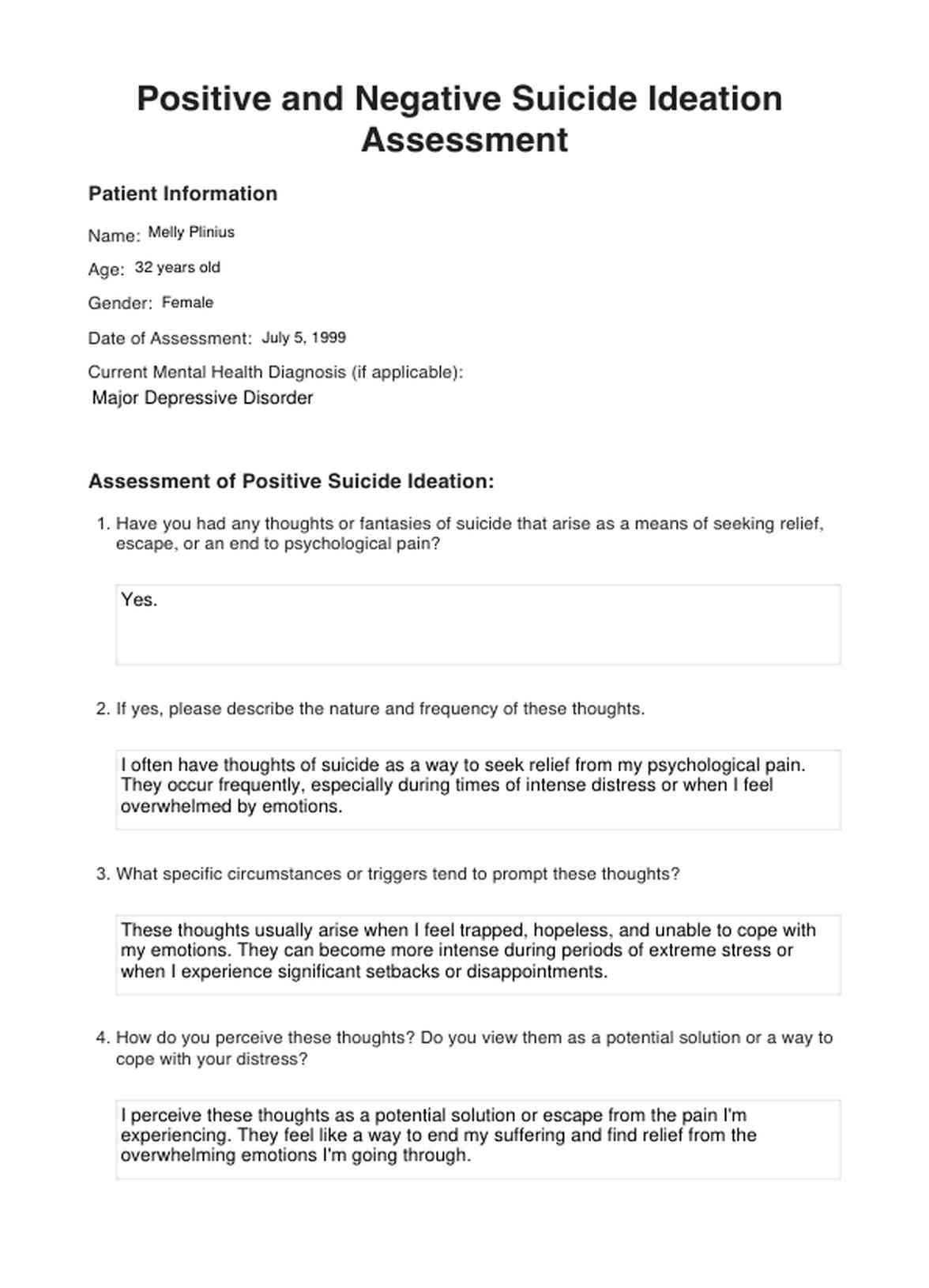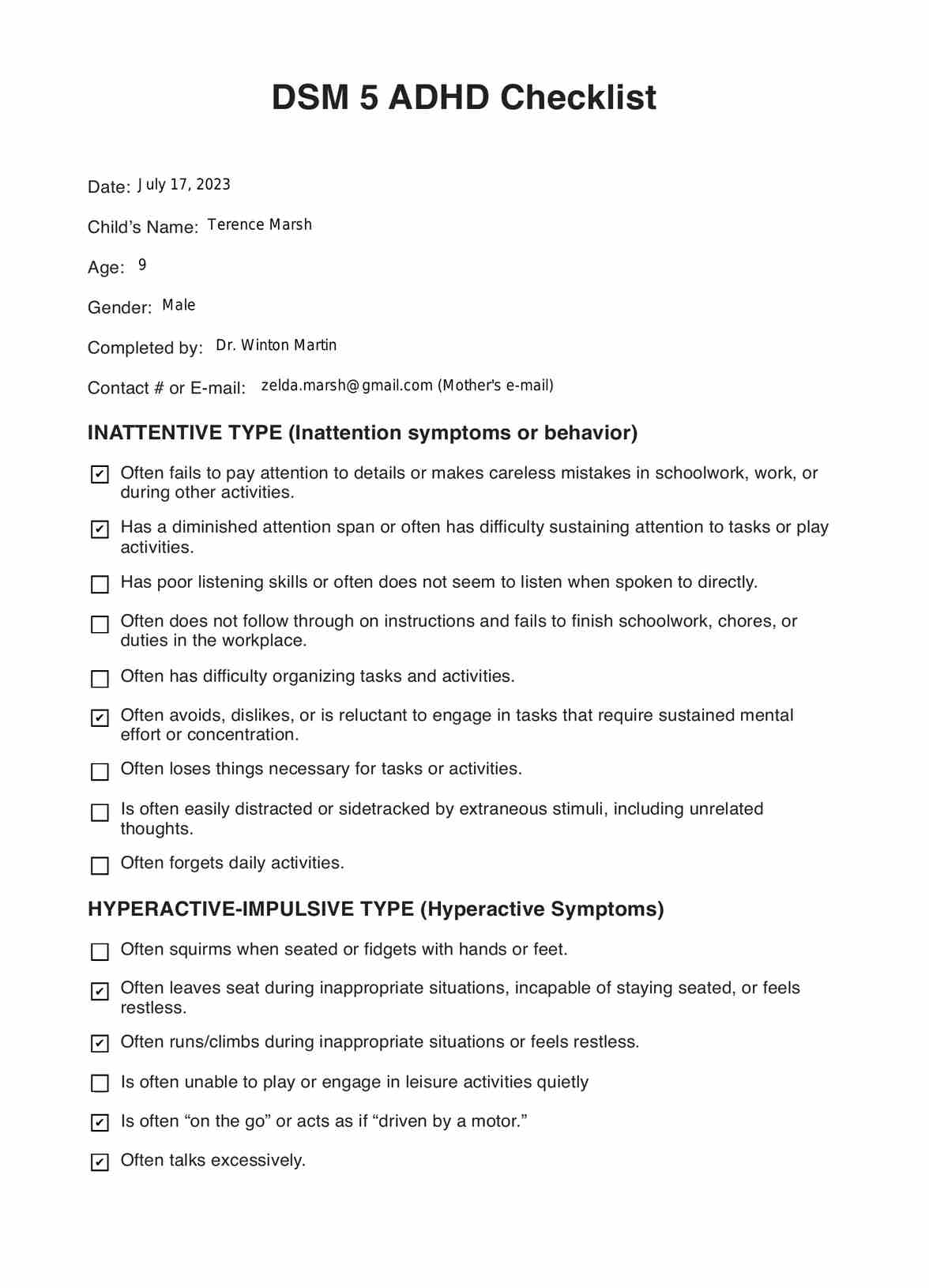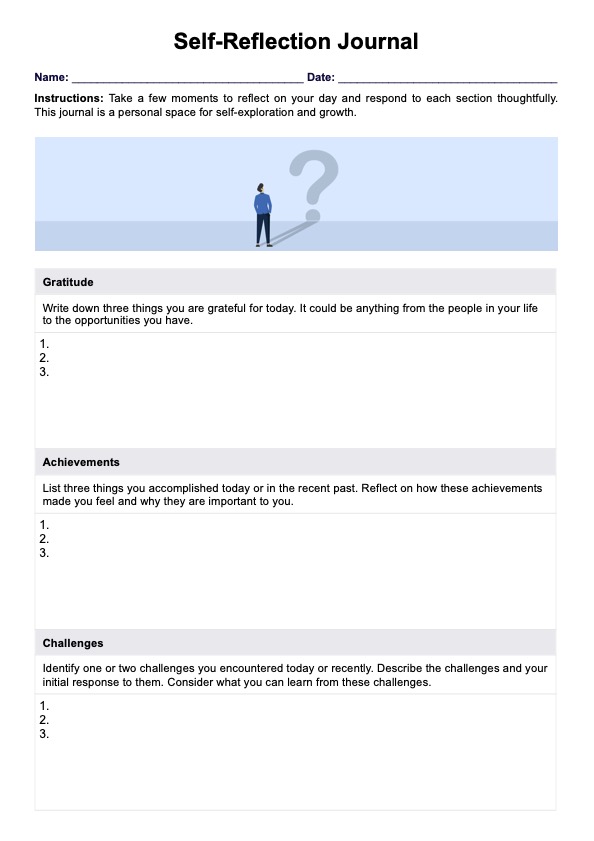Positive and Negative Suicide Ideation
Explore the complex realities of suicide ideation using the Positive and Negative Suicide Ideation tool. Get access to a free PDF template now.


What is a Positive and Negative Suicide Ideation?
Positive suicide ideation refers to thoughts or fantasies of suicide that arise as a means of seeking relief, escape, or an end to psychological pain. It is crucial to approach this concept with sensitivity and empathy, recognizing that individuals experiencing positive suicide ideation often believe death may relieve their overwhelming distress. Understanding the underlying factors contributing to positive suicide ideation can guide healthcare practitioners in formulating appropriate interventions and support strategies.
On the other hand, negative suicide ideation represents thoughts of suicide stemming from feelings of hopelessness, despair, and a belief that life has become unbearable. Negative suicide ideation can emerge due to various factors, such as untreated mental health disorders, significant life stressors, or a lack of social support. Identifying the presence of negative suicide ideation is crucial to prevent potential self-harm or suicidal behavior and requires immediate intervention and support from healthcare practitioners.
Healthcare practitioners play a pivotal role in assessing the risk of both positive and negative suicide ideation. A thorough evaluation of the individual's mental health history, current symptoms, and risk factors must be conducted. Developing a robust safety plan, involving collaboration with mental health professionals, and ensuring ongoing monitoring and support are vital components of intervention.
Providing comprehensive care for individuals experiencing suicide ideation requires a multidisciplinary approach. Collaboration between healthcare practitioners, mental health specialists, therapists, and support networks is essential. Promoting open communication, active listening, and a non-judgmental environment is crucial in establishing trust and encouraging individuals to seek help.
Positive and negative suicide ideation present distinct challenges for healthcare practitioners. Healthcare practitioners can provide effective interventions, support, and care by understanding the complexities associated with both aspects. Compassion, empathy, and ongoing collaboration are key in addressing this sensitive topic and working towards suicide prevention and mental well-being for those in need.
Positive and Negative Suicide Ideation Template
Positive and Negative Suicide Ideation Example
How does it work?
Here’s how to use the Printable Positive and Negative Suicide Ideation Assessment Template:
Download the Template
Obtain the printable Positive and Negative Suicide Ideation Assessment Template in a PDF or Word format.
Patient Information
Fill in the necessary patient information at the beginning of the template, including the patient's name, age, gender, and assessment date. Note any current mental health diagnosis, if applicable.
Assessment of Positive Suicide Ideation
Ask the patient a series of questions regarding their thoughts or fantasies of suicide to seek relief or escape from psychological pain. Encourage the patient to provide detailed responses about the nature, frequency, triggers, and perceived benefits or relief associated with these thoughts.
Assessment of Negative Suicide Ideation
Inquire about thoughts of suicide driven by feelings of hopelessness, despair, or a belief that life has become unbearable. Gather information on the intensity, contributing factors, perception of potential outcomes, and any plans or steps taken toward self-harm or suicide.
Risk Assessment
Evaluate the patient's risk level by exploring previous suicide attempts, current life stressors, access to lethal means, availability of social support, and ongoing mental health treatment.
Safety Plan and Intervention
Discuss the patient's existing safety plan or coping strategies. Determine the patient's ability to implement these strategies during episodes of suicidal ideation. Identify trusted contacts, crisis helplines, and emergency resources that the patient can utilize in times of crisis.
Customize and Adapt
Tailor the template to suit the specific needs of each patient. Modify or add questions based on individual circumstances and clinical judgment.
Ensure Confidentiality
Maintain patient confidentiality and adhere to ethical guidelines when handling the completed template.
Document and Follow-Up
Record the patient's responses accurately and comprehensively. Ensure appropriate documentation and follow-up procedures are in place, including referrals to mental health specialists or adjustments to the treatment plan.
When would you use this Template?
The Positive and Negative Suicide Ideation Template is a valuable resource for healthcare practitioners in mental health, psychology, counseling, and related fields. Here are some scenarios where this template can be appropriately utilized:
Initial Assessment
When conducting an initial assessment of a patient's mental health, this template can assist in evaluating the presence and severity of positive and negative suicide ideation. It provides a structured framework to gather essential information and establish a baseline understanding of the patient's suicidal thoughts.
Ongoing Monitoring
For patients with a history of suicide ideation or those currently receiving treatment, regular monitoring of their suicidal thoughts is crucial. The template can be used during follow-up appointments to assess any changes in the intensity or frequency of positive or negative suicide ideation.
Risk Assessment
The template aids healthcare practitioners in conducting a comprehensive risk assessment for patients exhibiting positive or negative suicide ideation. It helps identify potential risk factors, such as access to lethal means or lack of social support, enabling practitioners to develop appropriate intervention plans.
Safety Planning
When creating safety plans for patients at risk of suicide, the template provides a systematic approach to developing personalized strategies. It helps healthcare practitioners and patients collaboratively identify warning signs, coping mechanisms, emergency contacts, and available resources.
Treatment Evaluation
The template serves as a valuable tool for evaluating the effectiveness of interventions and treatment modalities. By documenting changes in positive and negative suicide ideation over time, healthcare practitioners can assess progress, identify areas that require additional support, and make informed adjustments to the treatment plan.
Referral and Collaboration
The template facilitates communication and collaboration between healthcare practitioners and mental health specialists. It is a concise document that can be shared with other professionals involved in the patient's care, ensuring continuity and coordination of services.
Benefits
Here are the benefits of using the free Positive and Negative Suicide Ideation Template:
Structured Approach
The template provides a structured framework for assessing positive and negative suicide ideation, ensuring thorough and consistent evaluations. It helps healthcare practitioners cover essential areas of inquiry, leaving no significant aspects overlooked.
Comprehensive Documentation
By utilizing the template, practitioners can document relevant information related to positive and negative suicide ideation in a comprehensive manner. This documentation can be a valuable reference for treatment planning, progress monitoring, and collaboration with other healthcare professionals.
Enhanced Communication
The template facilitates effective communication between healthcare practitioners and their patients. It provides a standardized format for discussing sensitive topics, allowing patients to express their thoughts and feelings more openly. This can contribute to a deeper understanding of their experiences and help build trust within the therapeutic relationship.
Time Efficiency
The template streamlines the assessment process by concisely presenting pertinent questions. This saves time for healthcare practitioners, enabling them to focus on actively listening to the patient's responses, conducting a thorough evaluation, and formulating appropriate interventions.
Continuity of Care
Using the template promotes continuity of care across different healthcare settings and professionals. It is a portable document that can be easily shared with other practitioners involved in the patient's treatment, ensuring a consistent and holistic approach to managing positive and negative suicide ideation.
Personalization and Adaptability
While providing a structured framework, the template allows customization based on individual patient needs. Healthcare practitioners can tailor and adapt the assessment questions to suit specific clinical contexts or patient demographics, ensuring a more personalized approach to care.
Research & Evidence
The Positive and Negative Suicide Ideation Template is a practical resource designed to aid healthcare practitioners in assessing and addressing suicidal thoughts. While the specific history of the template is not available, its development is likely rooted in the broader body of research and evidence surrounding suicide ideation assessment and intervention.
Numerous studies have examined the significance of assessing positive and negative suicide ideation to understand the complexity of suicidal thoughts. For example, research by Chu et al. (2017) emphasized the importance of considering both positive and negative aspects of suicide ideation, highlighting their distinct characteristics and potential implications for intervention strategies.
Using structured assessment tools in suicide ideation evaluation has been widely recommended. The template likely draws inspiration from established assessment measures, such as the Suicide Ideation Questionnaire (SIQ) developed by Reynolds (1987), which has been widely used to evaluate the presence and severity of suicidal thoughts in clinical and research settings.
Moreover, evidence supports the benefits of safety planning and intervention for individuals experiencing suicidal ideation. Stanley et al. (2009) conducted a randomized controlled trial and demonstrated that safety planning interventions significantly reduced suicidal behavior among participants.
While the specific evidence supporting the Positive and Negative Suicide Ideation Template is not explicitly stated, it is likely based on established research and best practices. The template's structure and content align with recommendations from professional guidelines, such as those provided by the American Foundation for Suicide Prevention and the American Association of Suicidology.
Healthcare practitioners need to remain updated on the latest research and guidelines related to suicide ideation assessment and intervention. Adapting the template based on current evidence and tailoring it to individual patient needs can enhance its effectiveness and promote positive patient outcomes.
References
Chu, C., Buchman-Schmitt, J. M., Stanley, I. H., Hom, M. A., Tucker, R. P., Hagan, C. R., & Joiner, T. E. (2017). The interpersonal theory of suicide: A systematic review and meta-analysis of a decade of cross-national research. Psychological Bulletin, 143(12), 1313-1345.
Reynolds, W. M. (1987). Suicidal Ideation Questionnaire (SIQ): Professional manual. Psychological Assessment Resources.
Stanley, B., Brown, G. K., Brenner, L. A., Galfalvy, H. C., Currier, D., Knox, K. L., ... & Stanley, M. (2009). Comparison of the safety planning intervention with follow-up vs usual care of suicidal patients treated in the emergency department. JAMA Psychiatry, 66(10), 1116-1123.
Commonly asked questions
Yes, positive and negative suicide ideation represent distinct aspects of suicidal thoughts. Positive suicide ideation focuses on seeking relief or escape, while negative suicide ideation is driven by a sense of hopelessness and the belief that life is unbearable.
Yes, both positive and negative suicide ideation are concerning and require attention. While positive suicide ideation may reflect an individual's attempt to cope with distress, it still indicates significant psychological pain. Negative suicide ideation signifies high despair and a perceived lack of options.
Healthcare practitioners can assess positive and negative suicide ideation through structured assessments using standardized questionnaires, clinical interviews, and open conversations with patients. Assessment tools and guidelines can assist in evaluating the presence, severity, and associated risk factors of suicidal thoughts.
Interventions for individuals with positive and negative suicide ideation may include safety planning, crisis intervention, psychotherapy, medication management, and building a strong support system. Treatment plans should be tailored to the individual's needs, focusing on reducing distress, enhancing coping skills, and promoting resilience.



















-template.jpg)































































































